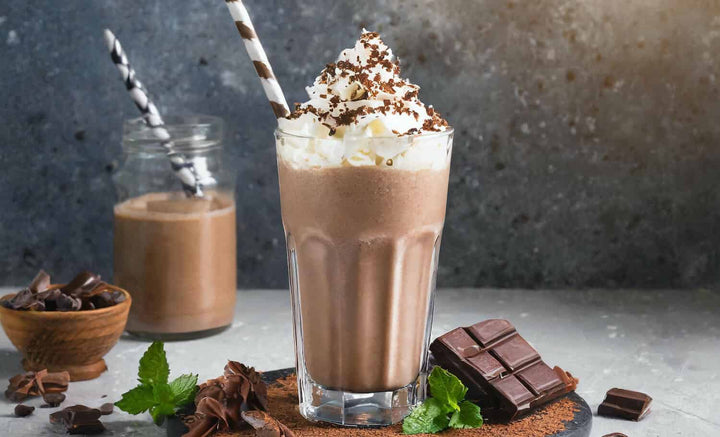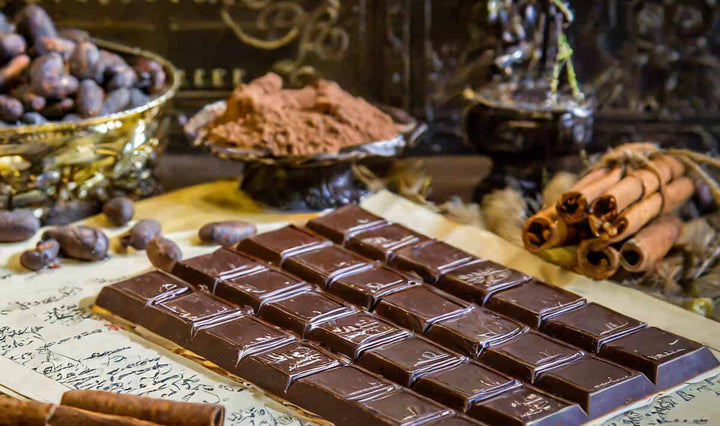The enchanting allure of chocolate has captivated palates and imaginations across the globe, its rich, velvety texture and diverse array of flavours creating a universal language of delight.
At the heart of every chocolate creation lies the humble cocoa bean, a small yet potent ingredient teeming with mysteries waiting to be uncovered.
Originating from the lush, tropical realms, cocoa beans are the essence of our cherished chocolate, and their journey from tree to treat is one of intricate processes and fascinating transformations.
In this post, we are set to embark on a delightful exploration into the world of cocoa beans, unravelling the myriad of facts about this magical entity.
Whether you're a connoisseur of fine chocolates or simply a lover of this sweet indulgence, join us as we delve into the captivating tales and intriguing intricacies surrounding the cornerstone of our favourite delicacy, enriching our appreciation for the age-old art of chocolate-making.
Related Post: Looking for a Cocoa Powder Substitute?
20 Cocoa Bean Facts
Here are twenty fascinating facts about cocoa beans, the enchanting entities behind our beloved chocolate:
-
Origin: Cocoa beans originate from the cacao tree, Theobroma cacao, a name given by the Swedish botanist Carl Linnaeus, which translates to ‘food of the gods’.
-
Regions: These beans are primarily grown in a belt between 10 degrees north and 10 degrees south of the Equator, predominantly in West Africa, South America, and Southeast Asia.
-
Harvesting: Cocoa beans are harvested by hand, as the use of machines could damage the delicate trees and pods.
-
Pods: The beans are encased in large, colourful pods, each containing around 20 to 60 beans enveloped in a sweet, white pulp.
-
Fermentation: After harvesting, the beans undergo fermentation, a crucial process that develops their characteristic chocolate flavour.
-
Drying: Post-fermentation, the beans are dried under the sun, a step essential to reduce moisture content and enhance flavour.
-
Classification: Cocoa beans are categorised into three main types: Criollo, Forastero, and Trinitario, each with distinct flavours and characteristics.
-
Nutrient-rich: Cocoa beans are packed with flavonoids, antioxidants, and essential minerals such as magnesium and iron.
-
Mood Enhancement: The beans contain compounds like theobromine and caffeine, known for their mood-enhancing and stimulating effects.
-
Income Source: Cocoa farming is the livelihood for millions of smallholder farmers, especially in developing countries.
-
Market Dominance: West Africa dominates the global cocoa market, with Ivory Coast being the largest producer, accounting for over one-third of the world’s supply.
-
Vulnerable to Disease: Cacao trees are susceptible to several pests and diseases, which can significantly impact yield.
-
Chocolate Production: It takes approximately 400 cocoa beans to make one pound (454 grams) of chocolate.
-
Child Labour Concerns: The cocoa industry has faced criticism and scrutiny due to the persistent issues of child labour and poor working conditions in some producing regions.
-
Sustainability Efforts: Many chocolatiers and organisations are working towards sustainable cocoa production to improve environmental, social, and economic impacts.
-
White Chocolate: Despite its name, white chocolate does not contain any cocoa solids, only cocoa butter extracted from the beans.
-
Demand Growth: The demand for cocoa is steadily increasing, with the rise of chocolate consumption in emerging markets.
-
Price Fluctuation: The price of cocoa beans on the international market is highly volatile, subject to fluctuations due to supply and demand dynamics.
-
Cocoa Butter: Cocoa butter, derived from cocoa beans, is a valued ingredient in cosmetics and skin care products due to its moisturising properties.
-
Fine Flavour Beans: Only a small percentage of the world’s cocoa beans are classified as ‘fine flavour’, sought after for their exceptional taste and aromatic profiles.
Each of these facts unveils a different facet of cocoa beans, inviting us to appreciate the journey and intricate processes that transpire before the velvety delight of chocolate dances upon our palates.
Related Post: What is Praline?
What Are Cocoa Beans?
Cocoa beans are the seeds extracted from the cacao tree pods, scientifically known as Theobroma cacao.
Indigenous to the deep tropical regions of Central and South America, these beans are the foundational ingredient in the production of chocolate and other cocoa products.
The term ‘Theobroma’ translates to ‘food of the gods’ in Greek, highlighting the longstanding reverence for this delectable foodstuff.
The journey of cocoa beans is a fascinating and meticulous one.
The beans are nestled within the colourful, football-shaped pods that grow directly on the trunk and larger branches of the cacao tree.
Each pod houses approximately 20 to 60 beans surrounded by a sweet, pulpy substance.
Once the pods are harvested, usually by hand to avoid damaging the trees, the beans are extracted and undergo a meticulous fermentation and drying process.
This is a crucial phase, allowing the development of chocolate's rich, characteristic flavours.
The dried beans are then transported to manufacturing facilities, where they are roasted, ground, and processed to produce various cocoa products, including cocoa powder, cocoa butter, and chocolate.
Beyond their central role in confectionery, cocoa beans are renowned for their nutritional value.
They are rich in antioxidants, flavonoids, and essential minerals like magnesium and iron, attributed to their various health benefits, including improved heart health and mood enhancement, thanks to compounds like theobromine and caffeine.
In summary, cocoa beans are the vital, revered seeds of the cacao tree, undergoing extensive processing to give rise to the diverse array of cocoa products and chocolate varieties we relish today.
They hold gastronomical significance and economic importance, particularly in regions like West Africa, which dominate the global cocoa production market.
What Are the Nutrients in Cocoa Beans?
| Nutrient | Amount per 100g | % Daily Value |
|---|---|---|
| Calories | 228 kcal | |
| Total Fat | 14 g | 18% |
| Saturated Fat | 8.1 g | 41% |
| Trans Fat | 0 g | |
| Cholesterol | 0 mg | 0% |
| Sodium | 18 mg | 1% |
| Total Carbohydrates | 58 g | 21% |
| Dietary Fibre | 33 g | 117% |
| Sugars | 1.5 g | |
| Protein | 20 g | 40% |
| Iron | 13.3 mg | 74% |
| Magnesium | 499 mg | 119% |
| Phosphorus | 734 mg | 59% |
| Potassium | 1524 mg | 32% |
| Zinc | 6.8 mg | 46% |
| Calcium | 128 mg | 10% |
| Theobromine | 2057 mg |
More Details:
Cocoa beans are rich in several nutrients essential for overall health:
-
Calories: They are calorie-dense, providing 228 kcal per 100g, contributing to energy needs.
-
Fats: Cocoa beans contain 14g of total fat, with 8.1g being saturated fat. The fats in cocoa are primarily healthy fats, essential for brain function and cellular health.
-
Carbohydrates: They contain 58g of total carbohydrates and a remarkable 33g of dietary fibre, essential for digestive health, accounting for 117% of the daily value.
-
Protein: With 20g of protein, cocoa beans are a good source of plant-based protein.
-
Minerals: They are rich in essential minerals, including iron, magnesium, phosphorus, potassium, zinc, and calcium, which play a pivotal role in various bodily functions such as bone health, muscle function, and oxygen transport.
-
Theobromine: Cocoa beans are a rich source of theobromine, a compound similar to caffeine, known for its mild stimulant effects and potential health benefits, including improved mood and heart health.
-
Antioxidants: Cocoa beans are laden with flavonoids, potent antioxidants that combat oxidative stress and inflammation, potentially reducing the risk of chronic diseases.
Ingesting cocoa beans or cocoa-derived products can hence contribute to the intake of essential nutrients and antioxidants, promoting overall well-being.
However, it’s crucial to consume them in moderation due to their calorie and fat content, especially when consumed as part of processed chocolate products, which may contain added sugars and fats.
What Are Cocoa Beans Used For?
Cocoa beans are the foundational elements in creating a myriad of products, owing to their versatile and rich attributes. Here’s a look into the varied uses of these cherished beans:
1. Chocolate Production:
The quintessential use of cocoa beans is in the crafting of chocolate.
The beans are fermented, dried, roasted, and ground to extract cocoa solids and cocoa butter, the pivotal components in the formation of chocolate, ranging from milk to dark and white variations.
2. Cocoa Powder:
Cocoa powder is derived by pressing roasted, ground cocoa beans to remove the cocoa butter, leaving behind the cocoa solids, which are then ground into a fine powder.
It is used in baking, cooking, or as a drink base due to its intense chocolate flavour and colour.
3. Cocoa Butter:
Cocoa butter, extracted from cocoa beans, is a valued ingredient in the culinary world for its smooth texture and rich, subtle flavour. It's used in making white chocolate and as a cooking fat.
Its stable fat composition makes it a preferred choice in baking and frying.
4. Confectionery and Baked Goods:
Cocoa products derived from beans are indispensable in creating a plethora of confectioneries and baked goods, like cakes, pastries, and cookies, lending them a distinctive taste and aroma.
5. Beverages:
Cocoa beans are used to make cocoa-based beverages, like hot chocolate and chocolate milk, cherished for their comforting and rich flavour profiles.
6. Cosmetics and Skincare Products:
Due to its moisturising properties and stability, Cocoa butter is extensively incorporated in the formulation of skincare products, cosmetics, and lip balms, offering hydration and a subtle aroma.
7. Health Supplements:
Due to their rich nutritional content and health benefits, cocoa beans and their derivatives are integrated into health supplements and products, aiding in heart health, mood enhancement, and providing antioxidants.
8. Culinary Ingredient:
In its varied forms, Cocoa is utilised as a flavouring agent and ingredient in numerous culinary dishes, from savoury to sweet, enhancing the overall taste and texture.
9. Therapeutic Uses:
The compounds in cocoa beans, such as theobromine and flavonoids, have been studied for their potential therapeutic benefits, including anti-inflammatory and mood-enhancing properties.
10. Artisanal Products:
Innovative and artisanal products like cocoa-infused oils, vinegar, and spices are also crafted from cocoa beans, expanding their reach in the culinary sphere.
11. Gardening:
Cocoa bean shells, a by-product of the chocolate-making process, are used as mulch and soil conditioners due to their nutrient-rich composition.
The multifaceted uses of cocoa beans underscore their significance and versatility in various domains, from culinary arts to skincare, highlighting their invaluable contribution to our daily lives and well-being.
Final Notes On Cocoa Bean Facts
Cocoa beans are not merely seeds; they embody a rich, multifaceted world of flavour and texture, a symbol of culinary artistry and tradition.
The cocoa bean's journey from a blossoming tree to a piece of luxurious chocolate is a meticulous process marked by passion, precision, and a relentless pursuit of quality.
The facts surrounding cocoa beans unravel the depth of their significance, highlighting their nutritional richness, their diverse applications, and their socio-economic impact.
These beans are not just the foundation of the delectable array of chocolate and cocoa products that grace our palates, but they also bear nutritional and therapeutic values, making them a revered ingredient in various domains.
Related Blog Posts:
- Click here for - Facts About Cacao Nibs Nutrition
- Click here for - Facts About Cocoa Powder Nutrition
- Click here for - Facts About Milk Chocolate Nutrition
- Click here for - Facts About Dark Chocolate Nutrition
- Click here for - Chocolate and Methylxanthines
- Click here for - Facts About White Chocolate Nutrition
- Click here for - Facts About Chocolate Nutrition











